Top News
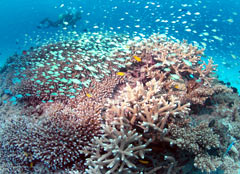
July 3, 2013 Ryukyu Shimpo
Before the end of 2013, the Ministry of the Environment will designate the coast of the Kerama Islands as a national park. Environment Minister Nobuteru Ishihara announced this at a press conference on July 2. Famous for their precious coral reefs, the Kerama Islands have very clear water at shallow depths, serve as habitat for a high concentration of about 250 species of coral, and are a breeding ground for humpback whales. They will become the 31st national park in Japan, and the first in 26 years since the Kushiro Marsh in Hokkaido in 1987. This May, in an attempt to restore the region devastated by the Great East Japan Earthquake, the Ministry reorganized the Rikuchu Kaigan National Park and other areas into the Sanriku Fukko National Park.

This August the Ministry will accept public comment on the national park designation. The members of an advisory body to the Environment Minister will visit the site in September in order to compile a report. The Ministry will then designate the Kerama Islands as a national park before the end of the 2013 fiscal year.
The Kerama Islands and the northern part of Okinawa Island coastal areas make up the Okinawa Coast National Park. The Ministry will designate the shallow area in which coral reefs live in high density as the sea park area and rest as the general area. Coral fishing, processing and sales will be regulated in the park area.
The Kerama Islands will be the second location for a national park in Okinawa, following the area extending over the waters and islands around Iriomote and Ishigaki Island, which were designated as the Iriomote Ishigaki National Park in 1972.
(English translation by T&CT, Mark Ealey)
Go to Japanese
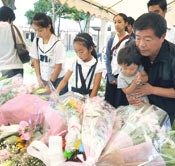
July 1, 2013 Ryukyu Shimpo
Fifty-four years have passed since June 30, 1959, when a U.S. F-100 fighter from Kadena Air Base crashed into Miyamori Elementary School in Ishikawa City (currently Uruma City). The Ishikawa and Miyamori 630 Association held the 54th anniversary memorial ceremony on June 30 at the school. Participants paid their respects to the 18 victims.
About 350 bereaved family members, people who were pupils at time of the crash, with their children and grandchildren and local residents attended. They said, “We will not let the tragedy happen again.”
The participants offered floral tributes to Nakayoshi-Jizo or Good Friend-Jizo (the protector of deceased children). The statue has the names of the 18 victims, including locals and pupils inscribed on it. At 10:40 a.m., the time that the military jet crashed, they offered silent prayers while the peace bell was ringing.
Mitsuteru Toyohama, the head of the association said, “The crash was an extension of the Battle of Okinawa. Why did they have to die 14 years after the war?” Toyohama said, “While the U.S.‐Japan Security Treaty protects the people in the main Islands of Japan, the Okinawan people do their best to protect themselves from U.S. military bases concentrated in the prefecture under the treaty.” He claimed that it is an ongoing contradiction since 1945 when the war ended.
Toyohama said, “We must not create a society that sacrifices children.”
Uruma Mayor Toshio Shimabukuro said, “The existence of the bases continues to put Okinawan people in danger. We must never allow such accidents to happen again.”
(English translation by T&CT, Mark Ealey)
Go to Japanese

Go To Video
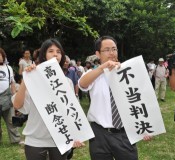
June 25, 2013 Ryukyu Shimpo
The Naha branch of the Fukuoka High Court rejected on June 25 an appeal by Masatsugu Isa, 51, who has been protesting against the construction of U.S. military helipads in Takae, Higashi.
The Okinawa Defense Bureau filed a lawsuit with the Naha District Court against two residents, including Isa, accusing them of obstructing traffic in 2010. The district court ordered Isa to stop staging sit-ins and other activities aimed at blocking the construction of a U.S. military helipad. The court judged his sit-in protest and his raising his hands to prevent gravel bags being brought in as going beyond expressive activity. However, the court dismissed the government’s claim that the other resident obstructed building work.
The defense bureau filed a lawsuit in 2008 with the Naha District Court against 15 residents, including a child, to stop their activities. When criticized, the government dropped the charges against the child.
(English translation by T&CT, Megumi Chibana and Mark Ealey)
Go to Japanese
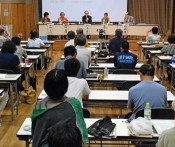
June 30, 2013 Ryukyu Shimpo
The 5th East Asian Critical Journals Conference was held on June 29 and 30 at Okinawa University to commemorate the 20th anniversary of the establishment of the quarterly journal Keshi-Kaji. Editors and researchers from Asian countries discussed working to create solidarity that will lead to peace. Keynote speaker Paik Nak-chung, professor emeritus at Seoul University, called for cooperation and exchange to overcome the nationalism that divides the people of East Asia.

Keynote speaker Paik Nak-chung, professor emeritus at Seoul University.
Paik, who founded the Quarterly Chngbi in 1966, has criticized the military dictatorship and the divided nature of the Korean Peninsula. Referring to U.S. bases on Okinawa, he commented that the United States has taken advantage of the internal structural contradictions in Japan to maintain its hegemonic power. According to the keynote speaker, tension between the two Koreas has become a pretext for the United States to preserve its bases on Okinawa and its power in East Asia. The professor said that there is a link between the Cold War structure on the Korean Peninsula and making the U.S. bases in Okinawa a permanent fixture. In addition, he commented that on a higher level, Okinawa would be a core spot for regional solidarity to resolve the problem of nationalism in the modern world. Paik hopes that a declaration of autonomy and self-government by the Yonaguni assembly and the agreement between the Yaeyama Islands and eastern Taiwan to promote tourism and economic exchange in 2009 will serve as a new model for cross-border regional solidarity.
“The island that has become a signpost for overcoming nationalism is being targeted by Japanese nationalism,” said Moriteru Arasaki, professor emeritus at Okinawa University. He pointed out that the China Threat theory regarding the Senkaku Islands and the PAC3 being deployed in response to North Korea’s missile launch has set the scene for the government to send Self-Defense Forces to Yonaguni. “The Japanese government is brazenly pushing ahead with a policy that rips apart the cross-border solidarity created by the people. How can we push back against this?”
(English translation by T&CT, Mark Ealey)
Go to Japanese
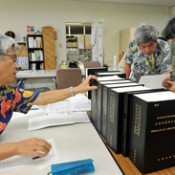
June 29, 2013 Ryukyu Shimpo
On June 28, the Okinawa Prefectural Government (OPG) made available to the public the application documents that the Okinawa Defense Bureau submitted to the OPG for permission to reclaim land at Henoko. They will be available for three weeks until July 18, at eight places, including the OPG Office, the Nago Municipal Office, and its branches. The OPG has also released the application on their website. The documents reveal that the cost of the reclamation is estimated at 231 billion and 87 million yen. The total construction cost, including that to build the air base is not given. The documents are six volumes totaling 8,800 pages, including the Environmental Impact Statement.

Flow of the application for reclamation.
This clearly sets out the annual budget and work plan for the five-year period of the project. During the inspection period, the OPG will accept opinions from people concerned.
The amount of earth and sediment for the landfill will be 21 million cubic meters. The Okinawa Defense Bureau is collecting material for reclamation at Motobu and Kunigami and 15 locations in other seven prefectures, including Tokunoshima in Kagoshima and Moji in Fukuoka. The documents include maps showing the diggings and routes for transportation, but do not give the actual amount taken from individual locations.
The Defense Bureau gives the results of soil analysis at Camp Schwab and around Henoko Dam, but does not provide them for the 17 million cubic meters of earth and sand that they will buy both in and outside of Okinawa. They will provide that information after completing the contract. The bureau plans to analyze the soil and will report on the results after all the application procedures are completed. The OPG will review the application documents with over 80 percent of the soil still unanalyzed. The Environmental Impact Statement submitted with the application is the same in content of that submitted previously. The Okinawa Governor has stated that under the current plan it would be impossible to protect the environment around the site. The bureau provided a letter in which the Nago Municipal Office disagreed with the reclamation plan based on the Public Water Body Reclamation Act. Nago claimed that the reclamation work would hinder the functions of the breakwaters of Henoko Fishing Port. On June 28, the bureau stated that it would be able to go ahead with the construction without Nago Municipal Office’s approval.
(English translation by T&CT, Lima Tokumori and Mark Ealey)
Go to Japanese
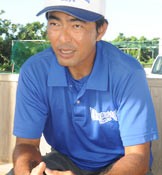
June 27, 2013 Taichi Hirayasu of the Ryukyu Shimpo
The manager of the team, Rin Ono, said, “This will be a valuable experience for the children. I want them to grow through the event.”
Ono played baseball at Okinawa Fisheries High School. His team came second in the National High School Baseball Championship for consecutive years in 1990 and 1991. Ono went on to play in professional baseball teams such as the Yomiuri Giants. He will be the manager of the Japanese national team at the 23rd World Children’s Baseball Fair to be held in the United States this August. Ono said, “Watching games played by teams from all over the world will be a valuable experience for the Japanese children.”
Ono currently coaches children of the junior high school hardball baseball team Uruma Higashi Boys. When he took part in international competitions during his high school and college years, the speed and power at the higher level surprised Ono. He said, “After experiencing world-class baseball, I worked hard to improve and eventually I became a professional.” He went on to say, “I want the children in the national team to watch teams from other countries and to boost their awareness of baseball and aspects of everyday life.”
Ono said, “I feel the weight of responsibility of being the manager of the national team and aim to win our games.” He went on to say, “The children in the team have real ability and winning will give them confidence.”
Sixteen children who play in boys’ leagues in various areas in Japan were selected for the team. To prepare for the event, they will hold a training camp in Fukuoka Prefecture from July 13 to 15.
The captain of the team, Taiki Nagahama, said, “My heart is racing. I will do my very best to lead the team.”
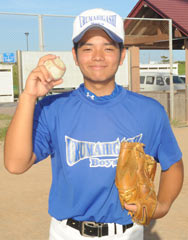
In Uruma, Uruma Higashi Boys pitcher Taiki Nagahama became captain of the team.
Nagahama, who is a pitcher from Uruma Higashi Boys, became the captain of the Japanese national team. He said, “I want to see how players from all over the world perform.”
Nagahama has been a pitcher since elementary school. He can adjust his style to pitch with breaking balls such as sliders and curveballs. Nagahama said, “I want to pitch on the international stage.” Nagahama said that he wanted to become the best pitcher of the world. He said, “I really want to grow through this competition.”
Ono has been coaching Nagahama in the Uruma Higashi Boys. Nagahama said, “I was able to get in the national team thanks to Mr. Ono’s training. I will do my best out of gratitude for Mr. Ono and want to win the gold medal for him.”
Nagahama leads the national team as captain. He said, “I will lead the other players with all my heart. I will tell them not to give up even if we are losing.” He went on to say, “First of all, I want to enjoy the event. I want to enjoy playing out of gratitude to our parents and those who have supported us.”
(English translation by T&CT, Mark Ealey)
Go to Japanese
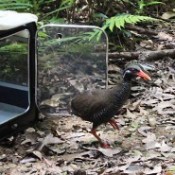
June 28, 2013 Ryukyu Shimpo
On June 27, a female Yambaru kuina (Okinawan rail) rescued from a road accident was released in Yona, Kunigami. As of June 27, 20 road accidents this year have involved Yambaru kuina. This is the second highest figure after last year.
A local resident found the injured bird lying on a road in the early morning of June 18. According to the Yambaru Wildlife Conservation Center, this bird had injured its leg and was exhausted. The NPO Animal Hospital Okinawa took care of the bird.
Ichito Yamamoto, a conservation ranger at the Yambaru Wildlife Conservation Center said, “We want people to drive within the speed limit. If people find an injured bird they should please contact the center immediately. Swift action helps to save their lives. ”
(English translation by T&CT, Hitomi Shinzato and Mark Ealey)
Go to Japanese
June 24, 2013 Ryukyu Shimpo
On June 24, the Ginowan City Assembly unanimously adopted a protest resolution and a statement of written opinion on the United States Marine Corps redeployment. The Corps is planning to send more Marines to Okinawa, including aircraft to the Futenma in the Unit Deployment Program. It unanimously adopted resolutions protesting against a U.S. Air Force F-22 fighter belonging to Kadena Air Base crashing on May 28, and an incident of vandalism by an airman at Nodake on June 2.
The members of the assembly will visit the Okinawa Defense Bureau to protest in the afternoon of June 24.
The assembly adopted a protest resolution against Osaka Mayor Toru Hashimoto’s remarks by a majority vote 24 in favor, one against and one not present. The mayor suggested to a U.S. military commander in Okinawa that American soldiers should use adults entertainment business. He also said the Japan’s Second World War ‘comfort women’ system had been necessary.
(English translation by T&CT, Mark Ealey)
Go to Japanese
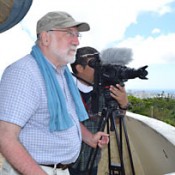
June 25, 2013 Naoki Isa of the Ryukyu Shimpo
American documentary filmmaker John Junkerman, 60, will make a documentary movie about the U.S. military base issue in Okinawa. The tentative title for the film is “Okinawa 1944-2014.” Currently living in Tokyo, Junkerman has been creating the movies such as “Nihonkoku kenpo the movie.”
Junkerman has been thinking of telling the base issue to U.S. citizens since 1975, when he lived in Okinawa.
Junkerman has taken 38 years to make this film because he feels responsible for the issue as an American citizen.
Junkerman lived in Okinawa City for six months in 1975.
He created “The Old Man and the Sea,” a documentary movie about a fisher from Yonaguni Island. Junkerman feels emotionally attached to Okinawa. The deployment of the Osprey to Okinawa, moving the U.S. Marine Corps Futenma Air Station to Henoko and the movement to revise the Japanese Constitution made him feel that he had to make the film.
The film tells the story of the ongoing issue of U.S. bases since the Battle of Okinawa.
The creators of the film interviewed American veterans suffering from serious illnesses they believe were caused by their exposure to Agent Orange in Okinawa. The film tells the complicated story of how U.S. soldiers are both the wrongdoers and the victims. Junkerman aims to complete the film next spring and to screen it in Japan and the United States.
Junkerman and Tetsujiro Yamagami, who represents the film production and distribution company Siglo that will produce Junkerman’s film, visited Okinawa from June 18 to 24.
Junkerman filmed the memorial service for bereaved family members of an incident of group suicide (normally referred to in Japanese as shudan jiketsu in which the Japanese military ordered or drove civilians to commit suicide) in Namihira, Yomitan. He also filmed the Cornerstone of Peace memorial and the area around Futenma Air Station.
Junkerman criticized Japanese cabinet officials who attended the Okinawa Memorial Service for all the war dead. He said, “It’s a performance. If they really feel for Okinawa they would change their policies towards the prefecture.”
Junkerman said, “The U.S. military’s occupation of Okinawa has continued for about 70 years. They do not let go of Okinawa because they think of it as a trophy. I would like to take this issue to ordinary U.S. citizens who do not know about it.”
Junkerman’s strong will was clear among his calm words.
(English translation by T&CT, Mark Ealey)
Go to Japanese

June 23, 2013 Kyoko Agarie, correspondent of the Ryukyu Shimpo
The Coral Preservation Association is trying to preserve coral by informing residents in Serikyaku on Izena Island about its importance. On June 14, the association worked with children to complete a large mural on the back of the head office of the Izena Fisheries Cooperative.
Mainly centered on about 120 cooperative members, the association has been working to preserve coral since three years ago.
The association has called the mural “Coral is a treasure of the sea.” One of its members, Yoko Higa, who teaches painting in Izena Elementary School, worked with the children from the Serikyaku Children Association and the school’s painting class. The children learned about the importance of coral from the project.
They painted sea creatures such as fish, crabs and sea slugs in with the coral.
Higa said, “The mural tells us that coral reefs provide a living environment for sea creatures as well for as humans. I want many people to see this mural that lets us know about the role of coral reefs.”
Nanami Kanzato, an eight-year-old pupil of the school said, “I used various colors to paint the coral. Pink and polka-dotted patterns made the painting beautiful. I want to look after the coral.”
(English translation by T&CT, Mark Ealey)
Go to Japanese
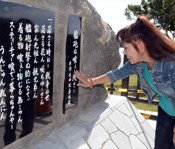
June 22, 2013 Ryukyu Shimpo
The monument featuring an Okinawa folk song Kanpo nu Kwe-nukusaa (Leftovers of the Warship) has been completed in Sobe in Yomitan. This well-known Okinawan folk song, written by Koubin Higa describes the feelings of people who survived the war.
The songwriter’s four daughters, who set up the Okinawan folk music group Deigo Musume, took part in the unveiling ceremony held on June 23.
Tsuyako Shimabukuro, Higa’s oldest daughter, said, “My father did not die in the war so his name is not on the Cornerstone of Peace memorial in Itoman. This is our father’s peace memorial.” She traced her fingers across her father’s name inscribed on the stone.
The song entitled Kanpo nu Kwe-nukusaa refers to the surviving Okinawan people being the scraps left over after the naval bombardment had eaten up their parents, families, houses and almost everything else on the islands.
In its light and easy rhythm, which includes some light-hearted lyrics, it tells of the sadness in the hearts of the people who lost family during the war and their wishes for peace. The song has aroused feelings of sympathy from many people. Higa lost six family members during the Battle of the Okinawa. He and his wife were killed in the car accident in 1973 when an American soldier driving under the influence of alcohol smashed into their car at Oyama in Ginowan. This year marks the 40th anniversary of their death. If he were still alive now, Higa would have celebrated the Kajimaya ceremony to mark the age of 97.
Chizuko Fukuhara, the songwriter’s third daughter, still remembers her father singing the song in the middle of the night as he played the sanshin. She said tearfully, “I want to thank everyone who helped to set up this monument. My father was a humble and self-effacing man, but I think that he would be happy.”
Geno Ikehara, the leader of the group that erected the monument, said, “Each one of us has a similar story to that of Kanpo nu Kwe-nukusaa. I want people to pass down this song to their children and grandchildren.”
(English translation by T&CT, Mark Ealey)
Go to Japanese















 Webcam(Kokusai Street)
Webcam(Kokusai Street)


